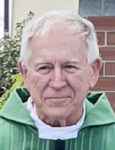By Fr. Bud Grant
SAU Theological Perspective

Among other earthly delights, October gives us the Feast of the Patron Saint of the Earth, Francis of Assisi (1182-1226). The feast of St. Kateri Tekakwitha, (1656-1679), also our patron of nature, is July 14.
A couple of weeks ago, in what Henry David Thoreau (our secular patron saint of nature) referred to as “the finest days of the year,” I was walking with my dog observing quixotic micro-migrations all around me. For instance, a caterpillar emerged from the rank foliage of the ditch and set out on an epic trek across the gravel road to, well, more rank foliage. I’m sure there’s a homily here somewhere.
I was tempted to give the little tyke a lift, but everyone has to make their own pilgrimage. Besides, we humans too often make a muck of things when naively acting on our good intentions. A quarter of a mile later I saw yet another caterpillar just about to complete the same quest, ‘cept in the opposite direction. Now, I’m certain there’s got to be a homily.
We also encountered butter-colored butterfly clusters that collected in the least likely place, the powdered gravel dust on the verge of the vegetation. Z (my dog) cluelessly walked right through one congregation, causing it to burst into a flutter. It was really kinda beautiful, like a tiny storm, but swirling up instead of down and made of creamy gold biotic filaments.
The whole time I sensed that nature was stirring, unconsciously preparing for a change of scenery. Even the plants were getting restless. The golden rod were bobbing their heavily laden heads with a kind of impatience. Maximillian Sunflowers were in full bloom, decorating the intersecting ditches like nature’s balloons, as if advertising some kind of party nearby. I supposed that these had migrated from my place but I’d not interfered deliberately: native plants migrate to wherever they can flourish. Sure wish Compass Plant liked my address.
New England Astor, which I do have, was also in bloom. Autumn seems to prefer blues and especially yellows and these dime-sized rosettes have both, in baroque bouquets that bow down the stalks as if in homage. Same with the tall grasses, Prairie Cordgrass and Big Bluestem. My apple tree was similarly laden with small buggy fruits bursting with sweetness. Only that giant alien ragweed remains insolently unbowed. On the other hand, it’s probably propping up my fence, so there’s a grace there.
Well, what’s the point of this revere to what the Decembrists call the “turning of the season?” Perhaps its no more meaningful than absurdly cross-migrating caterpillars. Perhaps each cycling of the season is a sign from God that death is the precursor of life. Or maybe we’re to recognize that it isn’t the destination that matters, but the journey, together. After all, even our destination, God willing, will be quite like what we are already and always able to access, surrounded as we are by such Franciscan beauty: “Praised be you Oh Lord, for All Your Creatures.”
(Father Bud Grant is a professor of theology at St. Ambrose University in Davenport.)








